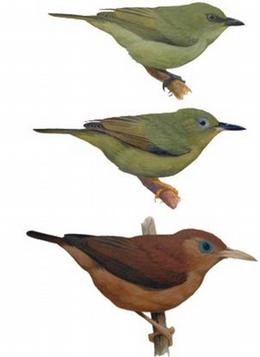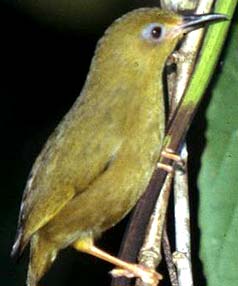New White-Eye Discovered
Posted by: Loren Coleman on March 14th, 2009

Vanikoro White-eye (middle) differs from other family members by having a distinctively shaped bill. Credit Adam Bowley.
In a remarkable event coinciding with the 200th birthday of Charles Darwin, scientists have discovered a new species of bird in the Solomon Islands and, they say, one which strikingly proves the theory of evolution.

In Origin of the Species Darwin used Galapagos finches to demonstrate evolution but Birdlife say he’d have done better with the White-eyes.
Like Darwins finches, these birds have evolved unique beak structures and feeding behaviour in the absence of competitors, says Dr. Guy Dutson of Birds Australia (BirdLife in Australia) who identified the new species.
Vanikoro White-eye – scientifically known as Zosterops gibbsi – differs from other family members by having a distinctively shaped bill; along with different leg and eye-ring colours.
“Genetic research has shown that white-eyes evolve new species faster than any known bird family,” said Guy Dutson. “Islands only 3 kilometres apart in the Solomons have their own white-eye species, and the Solomon Islands alone have 13 species of white-eye.
“Like Darwin’s finches, these birds have evolved unique beak structures and feeding behaviours in the absence of competitors”, Dutson added.
Vanikoro White-eye differs from the geographically closest white-eye, the Santa Cruz White-eye by having a longer bill, and different leg and eye-ring colour.
White-eyes are small sociable birds of tropical forests. Many have a conspicuous ring of tiny white feathers around their eyes. Vanikoro white-eyes are found in forest habitats, mostly above 350 metres, and feed on insects and small fruits.
Vanikoro White eyes were abundant towards the summit of the highest mountain, Dutson says.
Up to three adults fed chicks at a single nest, suggesting cooperative breeding, which has only been documented in two other white-eye species.
Vanikoro White-eye displays different feeding behaviours to closely-related birds.
This new species forages in a slower, more methodical manner than similar white-eyes, suggesting they have evolved into an empty niche, Dutson said.
About Loren Coleman
Loren Coleman is one of the world’s leading cryptozoologists, some say “the” leading living cryptozoologist. Certainly, he is acknowledged as the current living American researcher and writer who has most popularized cryptozoology in the late 20th and early 21st centuries.
Starting his fieldwork and investigations in 1960, after traveling and trekking extensively in pursuit of cryptozoological mysteries, Coleman began writing to share his experiences in 1969. An honorary member of Ivan T. Sanderson’s Society for the Investigation of the Unexplained in the 1970s, Coleman has been bestowed with similar honorary memberships of the North Idaho College Cryptozoology Club in 1983, and in subsequent years, that of the British Columbia Scientific Cryptozoology Club, CryptoSafari International, and other international organizations. He was also a Life Member and Benefactor of the International Society of Cryptozoology (now-defunct).
Loren Coleman’s daily blog, as a member of the Cryptomundo Team, served as an ongoing avenue of communication for the ever-growing body of cryptozoo news from 2005 through 2013. He returned as an infrequent contributor beginning Halloween week of 2015.
Coleman is the founder in 2003, and current director of the International Cryptozoology Museum in Portland, Maine.










Beuatiful creatures, they remind me of KIWIS